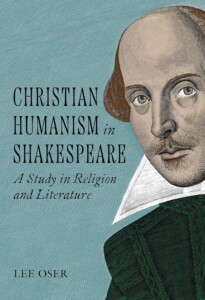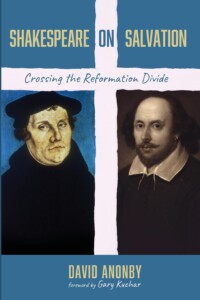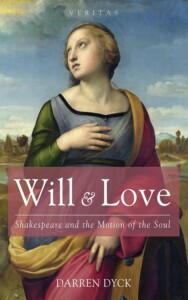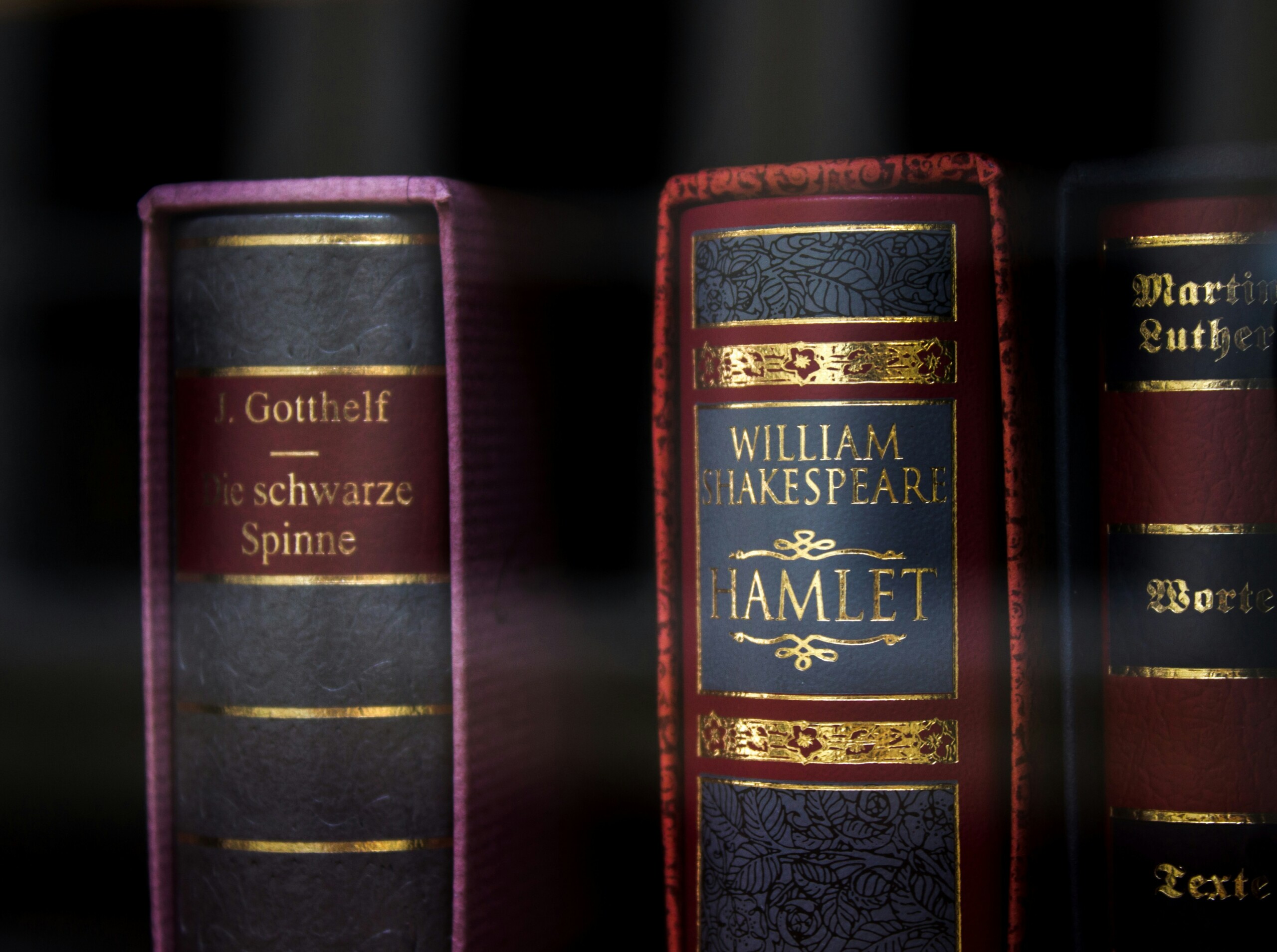
Christian Humanism in Shakespeare: A Study in Religion and Literature

Shakespeare on Salvation: Crossing the Reformation Divide

Will & Love: Shakespeare and the Motion of the Soul
David Anonby also begins Shakespeare on Salvation: Crossing the Reformation Divide with a reasoned defense for his engagement with religion in Shakespeare, invoking some of the same scholars that Oser does in his introduction. Anonby describes those in the turn to religion who have challenged the “secularizing narrative of the [Renaissance commercial] theater” (4), before turning to scholars who have more pointedly addressed soteriology in Shakespeare, Anonby’s specific project. Anonby summarizes the matter succinctly:
This volume hopes to contribute to the recovery of a greater understanding of the relationship between early modern religion and Shakespearean drama, a relationship which twentieth century criticism tended to dismiss as tenuous or to politicize as oppositional, but which the turn to religion in early modern scholarship of the past decade and a half has increasingly recognized as highly complex, sophisticated, and interdependent. (27)
In particular, Anonby will argue in his close reading of four plays that Shakespeare’s representation of soteriology engages the theological controversies among and between Catholics and Protestants in Elizabethan and Jacobean England. He refers to the project as “recovering the soteriological deep structures” in the plays (27).
In the first chapter, on The Merchant of Venice, Anonby suggests that the treatment of Shylock the Jew by his Christian adversaries dramatizes the otherness that Roman Catholics experienced in Elizabethan England. The superficial approach to Shylock in Venice interprets the Jew as law and the Christian as grace, whereas Anonby posits “a more nuanced dialectic between salvation by works . . . and salvation by faith and grace” (38). Anonby begins with a subtle critique of Portia’s famous courtroom performance, in the central and climactic scene of the play, an apt setting for unpacking the Lutheran notion of forensic justification. Not only is Portia’s invocation of mercy undermined by vindicative and self-justifying Venetians, but the play also proceeds to coerce Shylock to convert to Christianity, a practice viewed with some suspicion and associated in the minds of Shakespeare’s audience with requiring Catholics in England to swear the Oath of Supremacy. In the book’s conclusion, Anonby summarizes this part of his argument regarding The Merchant of Venice as “Shakespeare’s ethical critique of the cardinal doctrine of the Reformation, justification by faith alone” (256–7). The latter half of the chapter consists of sections on St. Paul and Luther’s anti-Judaism; faith and works (salvation and ethics); Richard Hooker’s moderate position between Protestant and Catholic soteriology; and the drift from spiritual to carnal love in the play’s resolution. Worthwhile in themselves as illustrative of the turn to religion, these sections relate somewhat loosely to the primary argument of the chapter.
Anonby devotes two chapters to Hamlet to demonstrate how the doctrine of salvation is central to our understanding of the play. Chapter 2 makes the case that Claudius’s prayer in Act 3 reflects the theology that Lancelot Andrewes develops in his twenty sermons on Cain (1599), specifically the free-will position that will later be associated with the name of Arminius and will become the predominant theology of salvation in the Church of England. Anonby leans into the theological differences between the two versions of Hamlet, with the Q1 version of Claudius’s prayer reflecting a Calvinist and Q2 an Arminian articulation of salvation. Whereas Oser argues that the play emphasizes providence over personal agency, Anonby concludes that “free will strikes a louder chord than predestination” (83). Chapter 3 turns to another locus of critical debate regarding Hamlet: the nature and role of the ghost. Anonby makes a plausible case for giving the ghost a religious and spiritual significance, particularly in reading the scene in the tradition of discretio spirituum. In short, Hamlet fails the test of properly discerning the spirit by choosing violent vengeance as his course of action. The argument that the crowing of the rooster at the departure of the ghost and Claudius’s use of the word “sift” are allusions to the testing of Peter is less convincing, particularly since Shakespeare’s preferred English translation of the New Testament, the Geneva Bible, uses the word “winnow” not “sift” in Luke 22:31. Taken together, these chapters offer a credible reading of Hamlet with a historically-contextualized theological hermeneutic.
The theological reading of Measure for Measure in chapter 4 demonstrates the incompatibility of the multiple manifestations of substitution and the ethical standard which the play purports to uphold. The “measure for measure” of the title directly invokes the words of Christ (Matthew 7:2) and invites a biblical ethical framework for our reading of the play. Vicarious atonement, of course, is crucial to both Catholic and Protestant soteriology, and the play certainly casts the moral dilemma of Isabella and Mariana in terms of substitutionary sacrifice, but the situation is more a parody than an allegory of Christian atonement. As Anonby puts it, “substitution works in Christian atonement but fails ethically when imposed on sexual praxis (and law)” (203). Anselm and Calvin provide the background to the theology of forensic justification that clearly validates Anonby’s dissatisfaction with the pardon that is granted to Angelo in the final scene: “Angelo’s egregious immorality seems to dissolve inexplicably in a mist of mercy” (175). Ultimately, the expedient confession and convenient forgiveness of the duke’s deputy reveals the moral failure at the heart of the play and indicates Shakespeare’s discomfort with eliding sacred and secular categories of church and state.
The final chapter, on King Lear, follows an oblique angle along what Anonby calls “two modes of para-soteriological discourse”: exorcism and martyrdom. Because exorcism and martyrdom are not confessional distinctives for Catholics and Protestants, these topics allow Anonby to read King Lear for its religious ecumenicity, as “cross-confessional, rather than partisan” (252). As in previous chapters, Anonby makes good use of material from the Early Modern period to situate Shakespeare in contemporary religious concerns. Samuel Harsnett’s A Declaration of Egregious Popish Impostures (1603) sets the stage for Shakespeare’s treatment of madness and Robert Southwell’s An Epistle of Comfort (1587) for the staging of martyrdom in King Lear. This approach is reflective of Anonby’s method of using texts of various genres to reconstruct Shakespeare’s theological environment. The fact that Shakespeare’s education was rudimentary (recall Ben Jonson’s phrase, “small Latin and less Greek”) does not mean that he was not conversant with the theological topics of his day. Shakespeare may not have read Luis de Molina (111–113), and certainly not those sermons by Lancelot Andrewes on Cain (published posthumously in 1657; 83–84), yet the controversies with which these writers engage are not incidental to the ecosystem of the Early Modern theater. In performing these controversies on the stage, the commercial Renaissance theater translates erudite, theological abstractions into experiential, affective realities that straddle Catholic and Protestant soteriology. Anonby suggests that, in the final analysis, King Lear moves Shakespeare toward a secular, skeptical soteriology, where the miracle of exorcism and the sacredness of martyrdom become human rather than divine acts.




















